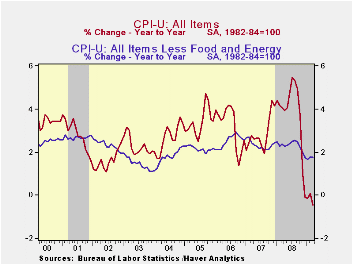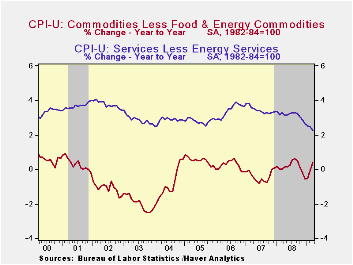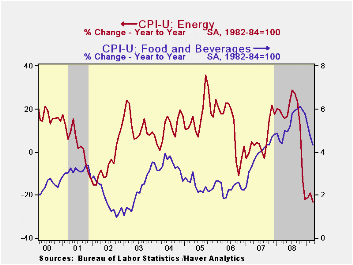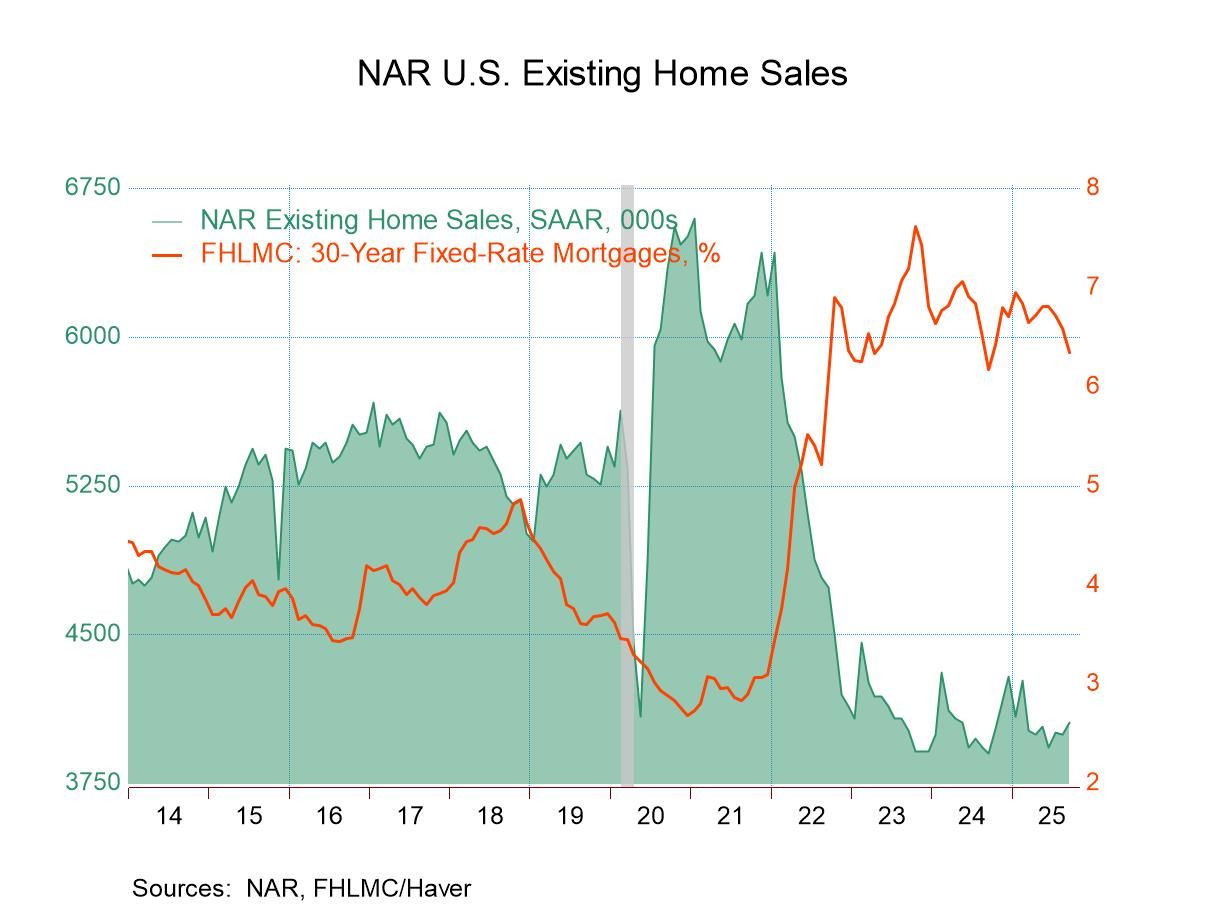 Global| Apr 15 2009
Global| Apr 15 2009Year-to-Year Drop In U.S. CPI Is First Since '55 Thanks To Energy & Food Prices
by:Tom Moeller
|in:Economy in Brief
Summary
Last month, the consumer price index published by the Bureau of Labor Statistics slipped 0.1%. The big news, however, was not the rare negative sign in front of the monthly figure but the negative sign in front of the twelve month [...]
 Last month,
the consumer price index published by the Bureau of Labor Statistics
slipped 0.1%. The big news, however, was not the rare negative sign in
front of the monthly figure but the negative sign in front of the
twelve month change. It was the first time since August 1955 that the
figure was negative. (Negative prints a few months ago reflected the
effects of seasonal adjustment factors.) The latest slip in the CPI
contrasts with Consensus expectations for a 0.2% March rise.
Last month,
the consumer price index published by the Bureau of Labor Statistics
slipped 0.1%. The big news, however, was not the rare negative sign in
front of the monthly figure but the negative sign in front of the
twelve month change. It was the first time since August 1955 that the
figure was negative. (Negative prints a few months ago reflected the
effects of seasonal adjustment factors.) The latest slip in the CPI
contrasts with Consensus expectations for a 0.2% March rise.
Leading that decline in prices was a reversal of earlier strength in energy & food costs. In contrast, "core" pricing recently picked up a bit. The CPI less food & energy rose 0.2% in each of the last three months and these increases actually were stronger than the -0.0% and 0.1% changes during the last four months of 2008. That pickup was enough to stabilize the twelve month change near 1.8% after its deceleration from a high of 2.9% back in September of 2006.
Lower energy prices in March were led by a 4.0% decline gasoline prices (-39.3% y/y) which reversed just half of the February increase. Even weaker last month were fuel oil prices which fell 7.7%. That was the eighth consecutive monthly drop and it lowered prices by nearly one-third during the last twelve. Similarly, prices for natural gas & electricity have fallen in all but one of the last eight months though they still were 2.6% higher than last March.
 Moderation of earlier gains in food &
beverage prices also has played a role in the overall CPI deceleration.
Prices slipped another 0.1% last month and the annual gain of 4.3% is
down from a peak of 6.1% last fall. Recent weakness has been led by
lower dairy product prices (-3.1% y/y) as prices of other foods
continued higher.
Moderation of earlier gains in food &
beverage prices also has played a role in the overall CPI deceleration.
Prices slipped another 0.1% last month and the annual gain of 4.3% is
down from a peak of 6.1% last fall. Recent weakness has been led by
lower dairy product prices (-3.1% y/y) as prices of other foods
continued higher.
Core goods prices have been up notably in recent months. The second consecutive 0.4% increase in March reversed all of the weakness since 2006. Higher tobacco prices account for much of that acceleration as they rose 18.1% year to year. But there has been some modest firming of prices elsewhere. Prices for household furnishings & operations show a 1.8% y/y gain following price deflation early last year. Prices of new & used motor vehicles also stopped declining during the last three months though they still are down 0.8% y/y. Apparel prices are up 1.4% y/y after modest deflation due to the weak Christmas.
Gains in core
services prices continue to moderate. The 0.1% upticks
during five of the last six months pulled year-to-year change to 2.3%
which was its lowest since 1983. That moderation continues to owe
mostly to weakness in the housing market which caused March shelter
prices to be unchanged and up just 1.5% y/y.  Owners equivalent rent of
primary residence, a measure not equivalent to other house price
measures, rose 0.2% (2.1% y/y) The cost of travel fell and prices of
lodging away from home have also dropped, by 7.8% during the last year.
Other service prices rose. The increase in medical care services prices
fell back to 0.2% (3.1% y/y) while education costs rose 0.5% (5.6%
y/y). Public transportation prices fell hard as they did
during the prior month. The 1.0% decline was the seventh drop in a row
(-5.0% y/y).
Owners equivalent rent of
primary residence, a measure not equivalent to other house price
measures, rose 0.2% (2.1% y/y) The cost of travel fell and prices of
lodging away from home have also dropped, by 7.8% during the last year.
Other service prices rose. The increase in medical care services prices
fell back to 0.2% (3.1% y/y) while education costs rose 0.5% (5.6%
y/y). Public transportation prices fell hard as they did
during the prior month. The 1.0% decline was the seventh drop in a row
(-5.0% y/y).
The chained CPI, which adjusts for shifts in consumption patterns, eased to a gain of just 0.2%. The increase in chained prices less food and energy continued firm at 0.4%. · The consumer price data is available in Haver's USECON database while detailed figures can be found in the CPIDATA database.
| Consumer Price Index (%) | March | February | Y/Y | 2008 | 2007 | 2006 |
|---|---|---|---|---|---|---|
| Total | -0.1 | 0.4 | -0.4 | 3.8 | 2.9 | 3.2 |
| Total less Food & Energy | 0.2 | 0.2 | 1.8 | 2.3 | 2.3 | 2.5 |
| Goods less Food & Energy | 0.4 | 0.4 | 0.4 | 0.1 | -0.4 | 0.2 |
| Services less Energy | 0.1 | 0.1 | 2.3 | 3.1 | 3.4 | 3.4 |
| Energy | -3.0 | 3.3 | -23.1 | 13.5 | 5.7 | 11.0 |
| Food & Beverages | -0.1 | -0.1 | 4.3 | 5.4 | 3.9 | 2.3 |
| Chained CPI: Total (NSA) | 0.2 | 0.6 | -0.8 | 3.3 | 2.5 | 2.9 |
| Total less Food & Energy | 0.4 | 0.4 | 1.3 | 2.0 | 2.0 | 2.2 |
Tom Moeller
AuthorMore in Author Profile »Prior to joining Haver Analytics in 2000, Mr. Moeller worked as the Economist at Chancellor Capital Management from 1985 to 1999. There, he developed comprehensive economic forecasts and interpreted economic data for equity and fixed income portfolio managers. Also at Chancellor, Mr. Moeller worked as an equity analyst and was responsible for researching and rating companies in the economically sensitive automobile and housing industries for investment in Chancellor’s equity portfolio. Prior to joining Chancellor, Mr. Moeller was an Economist at Citibank from 1979 to 1984. He also analyzed pricing behavior in the metals industry for the Council on Wage and Price Stability in Washington, D.C. In 1999, Mr. Moeller received the award for most accurate forecast from the Forecasters' Club of New York. From 1990 to 1992 he was President of the New York Association for Business Economists. Mr. Moeller earned an M.B.A. in Finance from Fordham University, where he graduated in 1987. He holds a Bachelor of Arts in Economics from George Washington University.






